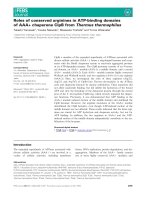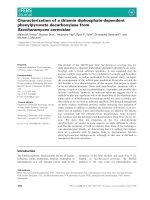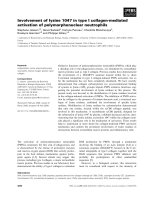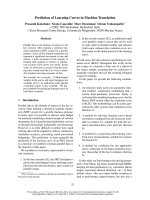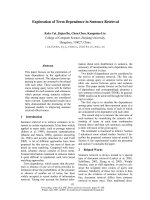báo cáo khoa học:" Assessment of Chronic Illness Care with the German version of the ACIC in different primary care settings in Switzerland" potx
Bạn đang xem bản rút gọn của tài liệu. Xem và tải ngay bản đầy đủ của tài liệu tại đây (372.57 KB, 5 trang )
RESEARC H Open Access
Assessment of Chronic Illness Care with the
German version of the ACIC in different primary
care settings in Switzerland
Claudia Steurer-Stey
1*
, Anja Frei
1
, Gabriela Schmid-Mohler
3
, Sibylle Malcolm-Kohler
2
, Marco Zoller
1
,
Thomas Rosemann
1
Abstract
Background: In Switzerland the extent to which patients with chronic illnesses receive care congruent with the
Chronic Care Model (CCM) is unknown.
Methods: According to guidelines we translated the Assessment of Chronic Illness Care (ACIC) into German (G-
ACIC). We teste d the instrument in different primary care settings and compared subscales with the original
testing.
Results: Difficulties encountered during the translation process consisted in the difference of health care settings
in Switzerland and USA. However initial testing showed the G-ACIC to be a suitable instrument. The average ACIC
subscale scores in Swiss managed care (MC)-, group (GP)- and single handed practices (SP) were higher for MC
practices than for group- and single handed practices: Organization of the healthcare delivery system: MC mean (m)
= 6.80 (SD 1.55), GP m = 5.42 (SD 0.99), SP m = 4.60 (SD 2.07); community linkages: MC m = 4.19 (SD 1.47), GP m =
4.83 (SD 1.81), SP m = 3.10 (SD 2.12); self-management support: MC m = 4.96 (SD 1.13), GP m = 4.73 (SD 1.40), SP m
= 4.43 (SD 1.34); decision support: MC m = 4.75 (SD 1.06); GP m = 4.20 (SD 0.87), SP m = 3.25 (SD 1.59); delivery
system design: MC m = 5.98 (SD 1.61), GP m = 5.05 (SD 2.05), SP m = 3.86 (SD 1.51) and clinical information systems:
MC m = 4.34 (SD = 2.49), GP m = 2.06 (SD 1.35), SP m = 3.20 (SD 1.57).
Conclusions: The G-ACIC is applicable and useful for comparing differe nt health care settings in German speaking
countries. Managed care organizations seem to implement the different components of the CCM in a greater
extend than group and single handed practices. However, much room exists for further improvement.
Introduction
The Assessment of Chronic Illness Care (ACIC) ques-
tionnaire was developed to assess if provided care is in
alignment with the Chronic Care Model (CCM) [1]. The
ACIC aims at organizational teams to help them to
identify areas for improvement for chronic illness care
and to evaluate the level and nature of improvements
made in their system. It is based on the six areas of sys-
tem change suggested by the CCM that have been
shown to influe nce quality of care [2]: organization of
health care, community linkages, self-management
support, decision support, delivery system design and
clinical information systems.
In Switzerland the extent to which patients with
chronic illnesses receive care congruent with the
Chronic Care Model (CCM) is unknown. To drive qual-
ity improvement programs, compare different health
care settings, and evaluate intervention studies, it is
necessary to have practical assessment tools in the
country’s own language. Although preconditions in dif-
ferent health care systems are different, the shortcom-
ings and gaps in chronic illn ess care addressed by the
six areas in the ACIC show analogy between all types of
medical settings and in different countries.
* Correspondence:
1
Department of General Practice and Health Services Research, University of
Zurich, University Hospital of Zurich, Sonneggstrasse 6, CH-8091 Zürich,
Switzerland
Full list of author information is available at the end of the article
Steurer-Stey et al. Health and Quality of Life Outcomes 2010, 8:122
/>© 2010 Steurer-Stey et al; licensee BioMed Central Ltd. This is an Open Access article distributed under the terms of the Creative
Commons Attribution License ( s/by/2.0), which permits unrestricted use, distribution, and
reproduction in any medium, provided the original work is properly cited.
We therefore developed a German translation of the
ACIC and tested the instrument in different primary
care settings in Switzerland.
Methods
Assessment of Chronic Illness Care (ACIC)
The ACIC is based on the specific interventions and con-
cepts within the CCM. It consists of 28 items covering
the six areas of the CCM: Organization of the healthcare
delivery system (6 items), community linkages (3 items),
self-management support (4 items), decision support
(4 items), delivery system design (6 items), and clinical
info rmation systems (5 items). Responses fall within four
descriptivelevelsD,C,B,Aof implementation ranging
from D “little or none” to A “fully implemented” inter-
vention. Within each of the four levels, respondents
choose one of three ratings of the degree to which that
description applies. The result is a 0-11 scale, with cate-
gories within this defined as follows: 0-2 (little or no sup-
port for chronic illness care); 3-5 (basic or intermediate
support for chronic illness care); 6-8 (advanced support);
and 9-11 (optimal, or comprehensive, integrated care for
chronic illness). Subscale scores for the six areas are
derived by summing the response. Bonomi et al showed
all six ACIC subscale scores to be responsive to health
care quality-improvement efforts [2].
Translation and cultural adaptation
After obtaining permission to use and tra nslate the
ACIC from the The MacColl Institute for Healthcare
Innovation, Group Health Cooperative [3] we followed a
translation approach (figure 1) according to the well
established guidelines of the “ ISPOR Task Force for
Translation” and the “ World Health Organization’ s
recommendations on the process of translation and
adaptation of instruments” in order to achieve the high-
est possible content validity [4,5], />substance_abuse/research_tools/en/.
Forward translation and reconciliation
Two translators independently translated the English
ACIC version into German. Toge ther with a 3
rd
mem-
ber of the research group reconciliation was carried out
into a single forward translation and first version.
Back translation
The back translator who was a native speaker of the ori-
ginal language English and unaware of the original Eng-
lish ACIC translated the 1
st
ACIC German version back
into the source language. In a multidisciplinary consen-
sus meeting where problematic items and translation
solutions were discussed a 2
nd
German version was
developed.
Cognitive debriefing
The 2
nd
version was tested for cognitive equivalence and
comprehensibility of the translation in a group of health
professionals (2 phy sicians, 2 medical practice ass istants,
2 clinical nurse specialists, 1 staff nurse).
Review of cognitive debriefing results and finalization
Subsequently, the project team discussed the profes-
sionals’ comments and issues that caused confusio n and
adjusted inappropriate items. This process led to the
final version of the German-ACIC, the G-ACIC.
Feasibility testing and validation in different primary care
institutions
The final German version was delivered to different pri-
mary care settings in Switzerland (two urban managed
care organisations (mediX Zürich, SWICA St.Gallen), 11
group practices (6 urban, 5 rural region) and 7 single-
handed practices (4 in rural regions and 3 urban) in order
to compare subscale scores achieved in these medical
organisations with those obtained in the original testing.
Figure 1 Translation process.
Steurer-Stey et al. Health and Quality of Life Outcomes 2010, 8:122
/>Page 2 of 5
Two researchers (AF, CSS) assessed completeness and
convergence or dissonance of the G-ACIC instrument
data. A sample of three physicians and two medical
practice assistants were interviewed individually about
acceptance and feasibility.
Results
The G-ACIC (see additional file 1) comprises 28 items
covering the six areas of the Chronic Care Model [2]
plus in congruence with the actual version 3.5 of the
ACIC [3] six additional items that address how well a
practice team or organization integrates the C hronic
Care Model elements.
The discrepancies we were faced with and which made
some modifications necessary were mainly due to the dif-
ferent health care settings and health care organization in
Switzerland. For instance, the health care professionals
had difficulties with the items benefits (Part 1: Organiza-
tion of the Healthcare Delivery System), regional health
plans (Part 2: Community Linkages) and planned visits
for chronic illness care (Part 3c: Delivery System Design).
We discussed the meaning of planned visits with regular
planned visits, incorporated patient goals, interactions to
support evidence-based care and regular follow-up. State-
ments varied from: “this is what we do anyway” to “this is
not institutionalized in the Swiss health care delivery sys-
tem” . We handled the wide range by using the terms
“Folgevisiten/Nachkontrollen” and “ Spezifische Visiten
für chronische Krankheitsversorgung” and by mentioning
the key elements of a planned visit within the four
descriptive levels D, C, B , A. Benefits was translated in
the meaning of financial support into “Zuschüsse”, regio-
nal health plans do not exist but health plans in Switzer-
land are supra regional on a cantonal or national base
and national in Germany as well, therefore the transla-
tion for regional health plans was adopted to “Kantonale
und nationale Gesundheitspläne”.
Addressing the fact that the implementation of new
tools into daily practice depends largely on practicability
and time constraint we asked the health professionals
who tested the German translation for comprehensibility
to also report on the time needed for the whole process.
The time effort ranked between 45 minutes and 20 min-
utes depending whether the form was filled out in a
team consensus approach or individually.
Two managed care (MC) organisations (mediX Zürich,
SWICA St.Gallen), 11 group practices (GP) and 7 sin-
gle-handed practices (SP) completed the G-ACIC for
the condition “diabetes”. The instrument was completed
individually by ten general practitioners and fifteen
times together with the medical practice assistants.
Table 1 gives an overview of the scores.
The average subscale scores ranged from 2.06 to 6.80
indicating limited to reasonably good support for dia-
betes car e. The Swiss managed care (MC) organizations
showed better results in most subscales compared to the
group practices and single handed practices. The MC
scores of decision support, delivery system design, and
information systems were comparable to the overall
baseline scores measured by Bonomi et al. [2]. The
score for health care organization was higher (6.80 vs.
6.42), whereas for the community linkages (4.19 vs.
5.90) and self-management areas (4.96 vs. 5.41) lower
scores were obtained (Table 1).
The group practices and single handed practices
scored lower in all subscales compared to the baseline
scores of the original testing. The group practices
showed for five of the six chronic care model elements
only basic support and regarding information systems
limited support for patients with diabetes. The subscale
scores for the single handed practices were below the
group practices with the exception of the information
systems element (Table 1).
Discussion
This paper describes the translation of the German ver-
sion of the ACIC and initial testing in different primary
care settings in Switzerland. Our experience shows that
Table 1 Average ACIC Scores Comparison between different Swiss primary care organizations and average ACIC scores
at start of Chronic Care Collaborative tested by Bonomi et al., 2002 (n = 90)
ACIC Subscale Scores
Organization Community
linkages
Self-
management
Decision
support
Delivery
system
design
Information
systems
Samples M SD M SD M SD M SD M SD M SD
Swiss managed Care practices (n = 7) 6.80 (1.55) 4.19 (1.47) 4.96 (1.13) 4.75 (1.06) 5.98 (1.61) 4.34 (2.49)
Swiss group practices (n = 11) 5.42 (0.99) 4.83 (1.81) 4.73 (1.40) 4.20 (0.87) 5.05 (2.05) 2.06 (1.35)
Swiss single handed practices (n = 7) 4.60 (2.07) 3.10 (2.12) 4.43 (1.34) 3.25 (1.59) 3.86 (1.51) 3.20 (1.57)
Overall (combined across collaborative) baseline scores
(Bonomi et al., 2002) (n = 90)
6.42 (1.82) 5.90 (2.30) 5.41 (2.00) 4.80 (1.99) 5.40 (2.23) 4.36 (2.19)
Steurer-Stey et al. Health and Quality of Life Outcomes 2010, 8:122
/>Page 3 of 5
the German version is applicable and the results suggest
that it is a useful tool to guide quality improvement in
chronic illness care in different health care organizations.
During the translation process some modifications
considering the different health care systems in USA
and Switzerland were necessary. Data from other coun-
tries using the ACIC to evaluate t he degree of imple-
mentation of the CCM report on efforts to adapt the
ACIC to the specific practice organization or even cre-
ated a new one with special emphasis on specific items
from the original version whereas others were not
assessed [6,7]. However we reached the decision to
develop a German translation addressing all six areas of
the original ACIC and not to develop a new instrument.
Overall the ACIC subscale scores obtained in the Swiss
samples were lower than the original scores of Bonomi
et al. [2]. Empirically institutions begin with average
scores below “5” on so me or all areas of the ACIC. Com-
parison between the three different Swiss primary care
settings showed high er scores in managed care practices,
which were nearly comparable to the original scores. The
higher scores in the m anaged care practices are likely to
reflect the “culture” of these organizations. For example
the mediX organization has been one of the first mana-
ged care organizations in Switzerland focusing on gate
keeping and on a team based patient centred approach in
health care. Electronic health records exist and the orga-
nization is active regarding quality improvement and
caring for people with chronic illnesses. Particularly for
the chosen condition diabetes strategies for coordinated
care are available [8]. Most GPs in Switzerland however
practice like in our study population solo o r in small
group organizations with one or two medical assistants.
Their relationship is often more hierarchical than team
based. Lack of resources and the still predominant tradi-
tion of paternalism instead o f partnership and multipro-
fessional c ollaborative care can explain the low scores in
delivery system design and community linkages. A survey
in Germany with primary care physicians either work-
ing solo or in an organization in cities with 20’ 000 to
1’000’000 inhabitants showed that barriers and difficulties
regarding community linkages were mentioned due to
time constraints but also lacking motivation by the
patients [9]. The low scores for information systems are
not surprising taking into account that the majority of
the small practices in Switzerland lack electronic health
records, registries and reminder systems.
Implementation of self-management support as a central
element of the CCM [1,10] and a key component in dia-
betes care was low in all three settings. Our own data for
asthma primary care in Switzerland showed that the
majority of patients get information only but not the skills
necessary for self-management [11]. Reported reasons
include the lack of confidence of health professionals in
patients self-managing their own condition, dislike of self-
management because misinterpretation as being disem-
powered, fearing loss of income, lack of time [12] and
inadequate training in teaching patients self-management
skills [13]. Finally the partnership and health care quality
paradigm within the CCM concept is not supported by
the payment system in Switzerland, a major barrier which
is also known in other countries [1,14].
The organizations for the initial testing of the German
version of the ACIC in Switzerland may not be repre-
sentative for all health care organizations in other
German speaking countries. However it can be assumed
that the difficulties in transforming usual care into care
congruent with the Chronic Care Model are similar.
Future projects should evaluate the German ACIC i n
different health care settings in German speaki ng cou n-
tries. Relationships between the quality of chronic care
delivered by the institution (ACIC) and the patients own
view assessed by the validated German version of the
patient assessment of chronic Illness care (PACIC)
should be answered by further research [15-17].
Conclusion
Clinicians and researchers benefit from a tool in their own
language to assess whether health care is in alignment
with the Chronic Care Model. The German version of the
ACIC takes a step forward on the journey to best practice
for chronic illness care in German speaking countries.
Additional material
Additional file 1: The German assessment of Chronic Illness Care: G-
ACIC. The German version consist of 28 items covering the six areas of
the Chronic Care Model plus in congruence with the actual version 3.5
of the ACIC six additional items that address how well a practice team or
organization integrates the Chronic Care Model elements.
Acknowledgements
The work of Claudia Steurer-Stey is supported by an unrestricted grant for
Chronic Care and patient education from AstraZeneca Switzerland.
We thank all persons and health professionals involved in the translation
process for their attendance and the helpful comments and inputs.
We thank the members of the “mediX Gruppenpraxis Zurich”, SWICA St.
Gallen and the physicians and medical practice assistants in the single
handed practices for initial testing of the German version of the ACIC.
Author details
1
Department of General Practice and Health Services Research, University of
Zurich, University Hospital of Zurich, Sonneggstrasse 6, CH-8091 Zürich,
Switzerland.
2
Department of Internal Medicine, University Hospital of Zurich
Rämistrasse, 100, CH-8091 Zürich, Switzerland.
3
Division of Nephrology,
University Hospital of Zurich Rämistrasse, 100, CH-8091 Zürich, Switzerland.
Authors’ contributions
CSS and TR were the initiators and devised the conceptual framework of the
paper. CSS drafted the report which the paper is based on and wrote the
paper but all authors contributed in writing and revising the manuscript. AF
did the statistical analysis.
Steurer-Stey et al. Health and Quality of Life Outcomes 2010, 8:122
/>Page 4 of 5
CSS and AF translated the original version into German, SMK did the back
translation into English and GSM was the leader of the group for the
comprehensibility testing. All authors participated in consensus meetings
and discussions.
All authors read and approved the final manuscript.
Competing interests
The authors declare that they have no competing interests
Received: 10 February 2010 Accepted: 27 October 2010
Published: 27 October 2010
References
1. Wagner EH, Austin BT, Michael Von K: Organizing Care for Patients with
Chronic Illness. The Milbank Quarterly 1996, 74(4):511-44.
2. Bonomi AE, Wagner EH, Glasgow RE, VonKorff M: Assessment of Chronic
Illness Care (ACIC): A practical tool to measure quality improvement.
Health Services Research. 2002, 37(3):791-820.
3. MacColl Institute for Healthcare Innovation: Assessment of Chronic Illness
Care Version 3.5 2010 [ />acic_v3.5a.pdf], [cited 2010 6 February].
4. Guillemin F, Bombardier C, Beaton D: Cross-cultural adaptation of health-
related quality of life measures: Literature review and proposed
guidelines. Journal of Clinical Epidemiology 1993, 46(12):1417-32.
5. Wild D, Grove A, Martin M, Eremenco S, McElroy S, Verjee-Lorenz A, et al:
Principles of Good Practice for the Translation and Cultural Adaptation
Process for Patient-Reported Outcomes (PRO) Measures: report of the
ISPOR Task Force for Translation and Cultural Adaptation. Value Health
2005, 8(2):94-104.
6. Strickland PA, Hudson SV, Piasecki A, Hahn K, Cohen D, Orzano AJ, et al:
Features of the Chronic Care Model (CCM) associated with behavioral
counseling and diabetes care in community primary care. J Am Board
Fam Med 2010, 23(3):295-305.
7. Sunaert P, Bastiaens H, Feyen L, Snauwaert B, Nobels F, Wens J, et al:
Implementation of a program for type 2 diabetes based on the Chronic
Care Model in a hospital-centered health care system: “the Belgian
experience”. BMC Health Serv Res 2009, 9:152.
8. Vecellio M: Ein digitales Patientenregister (diabetes databox) liefert
wichtige Daten: Ansätze zum Qualitätsmanagement bei Diabetikern in
der Hausarztpraxis. Care management 2009, 2(6):30-2.
9. Bölter R, Natanzon I, Miksch A, Joos S, Roseamnn T, Götz K: Kommunale
Ressourcen als ein Element des “Chronic Care Modells”. Prävention und
Gesundheitsförderung 2009, 4:35-40.
10. Bodenheimer T, Wagner EH, Grumbach K: Improving primary care for
patients with chronic illness: the chronic care model, Part 2. JAMA 2002,
288(15):1909-14.
11. Steurer-Stey C, Fletcher M, Vetter W, Steurer J: Patient education in
asthma: a survey of physicians’ knowledge of the principles and
implementation of self management in practice. Swiss Med Wkly 2006,
136(35-36):561-5.
12. Partridge MR: Written asthma action plans. Thorax 2004, 59(2):87-8.
13. Clark NM, Gong M: Management of chronic disease by practitioners and
patients: are we teaching the wrong things?
BMJ 2000, 320(7234):572-5.
14. Bodenheimer T, Wagner EH, Grumbach K: Improving primary care for
patients with chronic illness. JAMA 2002, 288(14):1775-9.
15. Glasgow RE, Whitesides H, Nelson CC, King DK: Use of the Patient
Assessment of Chronic Illness Care (PACIC) with diabetic patients:
relationship to patient characteristics, receipt of care, and self-
management. Diabetes Care 2005, 28(11):2655-61.
16. Glasgow RE, Wagner EH, Schaefer J, Mahoney LD, Reid RJ, Greene SM:
Development and validation of the Patient Assessment of Chronic
Illness Care (PACIC). Med Care 2005, 43(5):436-44.
17. Rosemann T, Laux G, Droesemeyer S, Gensichen J, Szecsenyi J: Evaluation
of a culturally adapted German version of the Patient Assessment of
Chronic Illness Care (PACIC 5A) questionnaire in a sample of
osteoarthritis patients. J Eval Clin Pract 2007, 13(5):806-13.
doi:10.1186/1477-7525-8-122
Cite this article as: Steurer-Stey et al.: Assessment of Chronic Illness Care
with the German version of the ACIC in different primary care settings
in Switzerland. Health and Quality of Life Outcomes 2010 8:122.
Submit your next manuscript to BioMed Central
and take full advantage of:
• Convenient online submission
• Thorough peer review
• No space constraints or color figure charges
• Immediate publication on acceptance
• Inclusion in PubMed, CAS, Scopus and Google Scholar
• Research which is freely available for redistribution
Submit your manuscript at
www.biomedcentral.com/submit
Steurer-Stey et al. Health and Quality of Life Outcomes 2010, 8:122
/>Page 5 of 5



